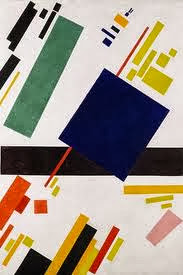My appreciation for Russian Avant-Garde Art runs deep, especially being an artist myself, living in America, where I was free to paint and express myself any way I'd like without consequences.
Although the oppression started many years before I was born, several artists I have admired lived in that period of history.
Among notable artists was Kazimir Malevich who's ideas of the avant-garde eventually clashed with the state direction of Socialist Realism.

In search of new forms of expression, the artists of the day
were highly eclectic in their art forms, and thus were prone to harsh criticism
for inclusion of such modern directions as impressionism and cubism, since
these movements existed before the revolution and hence were associated with
"decadent bourgeois art".
In the 1950s Moscow artist
Ely Bielutin encouraged his students to experiment with abstraction ism a
practice that was thoroughly discouraged by the Artists' Union ,
which strictly enforced the official policy of Socialist Realism. Artists who
chose to paint in alternative styles had to do so completely in private and
were never able to exhibit or sell their work. As a result, Nonconformist Art
developed along a separate path than the Official Art that was recorded in the
history books.
The most infamous incident regarding nonconformist artists
in the former Soviet Union was the 1974 Bulldozer Exhibition, which took place
in a park just outside of Moscow ,
and included work by such artists as Oskar Rabin, Komar and Melamid, Alexandr
Zhdanov, Nikolai Smoliakov and Leonid Sokov. The artists involved had written
to the authorities for permission to hold the exhibition but received no answer
to their request. They decided to go ahead with the exhibition anyway, which
consisted solely of unofficial works of art that did not fit into the rubric of
Socialist Realism. The KGB put an end to the exhibition just hours after it
opened by bringing in bulldozers to completely destroy all of the artworks present.
Fortunately for the artists, the foreign press had been there to witness the
event. The world-wide coverage of it forced the authorities to permit an
exhibition of Nonconformist Art two weeks later in Izmailovsky
Park in Moscow .
By the 1980s, Mikhail Gorbachev's policies of Perestroika
and Glasnost made it virtually impossible for the authorities to place
restrictions on artists or their freedom of expression. With the collapse of
the Soviet Union , the new market economy
enabled the development of a gallery system, which meant that artists no longer
had to be employed by the state, and could create work according to their own
tastes, as well as the tastes of their private patrons. Consequently, after
around 1986 the phenomenon of Nonconformist Art in the Soviet
Union ceased to exist.
And so it was, a creative struggle, that couldn't be contained, and eventually conquered in the end.
ENJOY THE JOURNEY MY FRIENDS...ZMAKEY
ZMAKEY ART STUDIO AND GALLERY
VISIT US AT ZMAKEYART-GOOGLE SITES
FACEBOOK-ZMAKEY ART STUDIO AND GALLERY
AND
FINE ART AMERICA.COM
FACEBOOK-ZMAKEY ART STUDIO AND GALLERY
AND
FINE ART AMERICA.COM

No comments:
Post a Comment